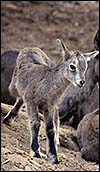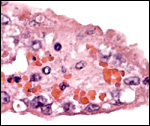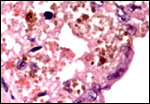| (Clicking
on the thumbnail images will launch a new window and a larger version
of the thumbnail.) |
| Last updated: August 7, 2006. |
Pseudois nayaur [szechuanensis]
Order: Artiodactyla
Family: Bovidae (Caprinae)
1) General Zoological Data
Two species are recognized, P. nayaur from the Himalayans to Mongolia , and P. schaeferi from Sichuan , China ( Nowak, 1999). Both are endangered or threatened species, but the Zoological Society of San Diego has had a thriving, reproductive herd of bharals since around 1990. Other herds of this rarely exhibited species were in London , Paris and Berlin (see Pohle, 1998).
Bharal is its Hindi name; pseudois refers to' false sheep' (absence of facial glands and a tail that more resembles a goat); nayaur presumably derives from the Nepali word nahur for sheep (Gotch, 1979). According to Gray (1972), bharals and sheep do not interbreed, but bharals are said to hybridize occasionally with goats although live offspring apparently do not occur (Bunch et al., 1978). Bharals weigh between 25 and 80 kg and are said to be closer to goats than to sheep in many respects (Schaller, 1977). This is so irrespective of their chromosome numbers that are closer to those of sheep. The shape of their horns is characteristic and it is borne by both males and females. The differences among Bharals, sheep and goat have been fully discussed in a paper by Bunch et al. (1978). These authors also made reference to their occasional hybridization with goats. Groups of up to 80 animals occur in the wild, but generally smaller numbers of animals are seen together. Their longevity is 20 years and 10 months, as recorded by Jones (1993). As indicated earlier, there is considerable dispute as to the proximity of the relationship of Pseudois to sheep or goats. While Pilgrim and Sokolov placed the species closer to sheep, Thenius (1960) placed them more closely with the goat forms. The most definitive study of these ambiguities has recently been provided by Hernandez Fernandez & Vrba (2005). This analysis also places the Bharal closer to goats than to the more ancestral sheep.
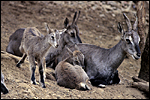 |
Bharals at San Diego Zoo. |
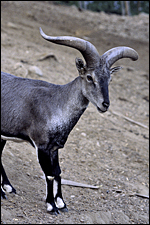 |
Adult male Bharal at San Diego Zoo. |
2) General Gestational Data
While bharals have single birth after a 160 day gestation period, twins are not infrequently seen; none were encountered in the large survey by Pohle (1998). The term placentas weigh around 200 g. The neonatal weight in our colony is around 2.5-3 kg, with a crown-rump length of 38-40 cm. Pohle (1998) described weight of newborns up to 4,400 g, usually from 3-4 kg.
3) Implantation
I have been unable to find any literature on the placental implantation or on early developmental features. The uterus is bicornuate.
4) General Characterization of the Placenta
Term Bharal placenta of live offspring. |
|
Another Bharal placenta with some putrefaction. |
|
This is a multicotyledonary placenta, similar to that of most Bovidae but possessing a smaller number of cotyledons than most forms. The first placenta shown here weighed 190 g, measured 60x13 cm in greatest diameters and had 31 flat cotyledons that varied from 2-4 cm in size and 1 cm in thickness. The second placenta weighed 200 g and had 35 cotyledons of similar dimensions. Its overall size was 48 x 11 cm. This is a typical chorioepithelial placenta with cotyledons forming over the endometrial caruncles.
5) Details of fetal/maternal barrier
The trophoblast covering the villi is cuboidal and composed of single cells with occasional binucleate trophoblast being present, as is the case in other ruminants. Unfortunately, the preservation of these two placentas was suboptimal and thus it was difficult to produce good microscopic representations. Beneath the chorionic surface are larger areas of pigmented debris and macrophages as well as some trophoblast containing the yellow/brown pigment. Typically, the pigment of this ‘hemophagous region' was Prussian blue negative.
6) Umbilical cord
The umbilical cords of these two placentas were 13 and 14 cm long, respectively. They contained 4 large and numerous small blood vessels, as well as a sizeable allantoic duct. There were no spirals or caruncles.
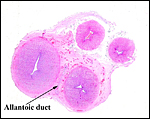 |
Cross section of the umbilical cord. |
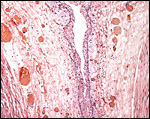 |
The allantoic duct in the umbilical cord is accompanied by numerous small vessels. |
7) Uteroplacental circulation
Presumably this is similar to that so extensively studied sheep placenta (see chapter on domestic sheep), but details are still forthcoming.
8) Extraplacental membranes
There was a large allantoic sac whose membrane had numerous tiny blood vessels and a flat epithelium. The avascular amnion had no regions of squamous metaplasia. There was no decidua capsularis.
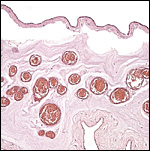 |
Amnion above, allantoic membrane below. |
The free membranes consist of a thin avascular amnionic layer and richly vascularized allantoic sac. The allantoic epithelium was thin and poorly preserved. Over the cotyledons, the amnion had a much more cuboidal appearance and its cytoplasm was vacuolar.
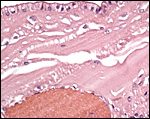 |
The amnion on the cotyledonary surface is more epithelial and slightly vacuolated. |
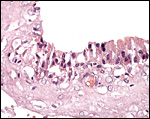 |
Membranes at edge of cotyledon are covered with tall trophoblast. |
9) Trophoblast external to barrier
I have not had a placenta that was implanted into the uterus; thus, trophoblast invasion cannot be judged, but it seems unlikely that it occurs.
10) Endometrium
There is no decidua in the ovine uterus but osteopontin is expressed in the endometrial stroma at the site of superficial endometrial erosion (Johnson et al., 2003). This further supports some syndesmochorial aspect of the placentation, as the osteopontin expression is absent in pigs. Endometrial glands remain as scattered islands below the cotyledons. Similar findings are expected to exist in Pseudois .
11) Various features
None.
12) Endocrinology
I have been unable to find any specific information on bharals.
13) Genetics
Bunch et al. (1978; 2000) studied one specimen of “dwarf blue sheep” from Tibet and then residing at the Henry Doorley Zoo in Omaha, Nebraska and found 2n=54, while a “Subei blue sheep – Greater form” had 2n=56, with the appropriate fusions of acrocentrics. They discussed at length the possible implications of such a potentially isolating mechanism and referred to similar events in Ovis coming forms from different countries. In the colony at the San Diego Zoo, chromosome numbers of 2n=54 (#5), 2n=55 (#4), and 2n=56 (#1) have been found without any identified correlation to phenotype or sterility. The animals mostly stem, both from Chengdu , China but several different acquisitions from other zoos have occurred. Interestingly, one animal was ‘mosaic' for 2n=54/2n=55.
Feng et al. (2001) sequenced portions of the mtDNA control region and Y-linked ZFY intron. They suggested from their results that the dwarf blue sheep is monophyletic and placed it into a subspecies of blue sheep. Henderson & Bruère (1980) described the nucleolus organizing region in bharals and other related species and found great similarities with sheep, goat, cattle and aoudad; moreover, the telomeric NORs of chromosome #3 resulted in a ‘ring chromosome'. G-banding patterns have been described for bharals with 2n=54 and compared with Ovis dalli stonei and Capra hircus (Bunch et al., 1978). They found great similarities in the banding of long arms of bharal and sheep, while the patterns were different in the short arms. They also measured the relative lengths of arms and found bharal to have a small biarmed chromosome that resembled goat and sheep. The Y-chromosome was a short acrocentric element. Hemoglobin B electrophoresis patterns were also similar, while transferrin migrated more slowly in Bharal.
Considering the fact that in the San Diego Zoo colony are animals with 54, 55 and 56 chromosomes and that no apparent sterility exists, the variable chromosome number is presumably irrelevant for reproduction and has little if any known phenotypic expression.. Much of this variability is also true for European Sus scrofa (see Gropp et al., 1969; Muramoto et al., 1965) – and it is also discussed in Hsu & Benirschke (1967). No sterility is thus incurred.
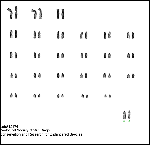 |
Karyotype with 2n=54. |
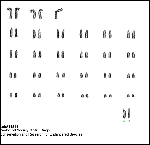 |
Karyotype with 2n=55. |
14) Immunology
I am not aware of any specific data applying to blue sheep.
15) Pathological features
I have not found any relevant literature on pathological findings this species.
16) Physiologic data
Sakai et al. (2003) studied the cardiopulmonary adaptation of blue sheep in high altitude chambers with those of pigs.
17) Other resources
DNA and cell strains are available from CRES at the Zoological Society of San Diego by contacting Dr. Oliver Ryder at: oryder@ucsd.edu.
18) Other remarks – What additional Information is needed?
It is apparent that more karyotypic data of defined species with defined origin are needed. Moreover, there is also no information on early placental development.
Acknowledgement
The animal photographs in this chapter come from the Zoological Society of San Diego.
References
Bunch, T.D., Nadler, C.F. and Simmons, L.: G-band patterns, hemoglobin, and transferrin types of the bharal: chromosomal evolutionary relationships with sheep and goats. J. Hered. 69:316-330, 1978.
Bunch, T.D., Wang, S., Zhang, Y., Liu, A. And Lin, S.: Chromosome evolution of the blue sheep/bharal ( Pseudois nayaur ). J. Hered. 91:168-170, 2000.
Feng, J., Lajia, C., Taylor, D.J. and Webster, M.S.: Genetic distinctness of endangered dwarf blue sheep ( Pseudois nayaur schaeferi ): evidence from mitochondrial control region and Y-linked ZFY intron sequences. J. Hered. 92:9-15, 2001.
Gotch, A.F.: Mammals – Their Latin Names Explained. Blandford Press, Poole , Dorset , 1979.
Gray, A.P.: Mammalian Hybrids. A Check-list with Bibliography. 2 nd edition.
Commonwealth Agricultural Bureaux Farnham Royal, Slough , England , 1972.
Gropp, A., Giers, D. and Tettenborn, U.: Das Chromosomenkomplement des Wildschweines ( Sus scrofa ). Experientia 25:778, 1969.
Henderson , L.M. and Bruère, A.N.: Nucleolus organizer region location and ‘ring' chromosomes in the bharal. Experientia 36:176-178, 1980.
Hsu, T.C. and Benirschke, K.: Mammalian Chromosome Atlas. Vol. 1, Folio 39, 1967. Springer-Verlag , New York .
Johnson, G.A., Burghardt, R.C., Joyce, M.M., Spencer, T.E., Bazer, F.W., Pfarrer, C. and Gray , C.A. : Osteopontin expression in uterine stroma indicates a decidualization-like differentiation during ovine pregnancy. Biol. Reprod. 68:1951-1958, 2003.
Jones, M.L.: Longevity of ungulates in captivity. Intern. Zoo Yearbk. 32:159-169, 1993.
Muramoto, J., Makino, S., Ishikawa, T. and Kanagawa. On the chromosomes of the wild boar and the boar-pig hybrids. Proc. Jap. Acad. 41:236, 1965.
Nowak, R.M.: Walker 's Mammals of the World. 6 th ed. The Johns Hopkins Press, Baltimore, 1999.
Pohle, C.: Erste Erfahrungen mit Blauschafen (Pseudois nayaur). Milu 9:376-383, 1998.
Sakai , A., Matsumoto, T., Saitoh, M., Matsuzaki, T., Koisumi, T., Ischizaki, T., Ruan, Z.H., Wang, Z.G., Chen, O.H. and Wang, X.O.: Cardiopulmonary hemodynamics of blue-sheep, Pseudois nayaur , as high-altitude adapted mammals. Japan J. Physiol. 53:377-384, 2003.
Schaller, G.B.: Mountain monarchs: wild sheep and goats of the Himalaya . Univ. Chicago Press, 1977.
Thenius, E. and Hofer, H.: Stammesgeschichte der Säugetiere. Eine Uebersicht über Tatsachen und Probleme der Evolution der Säugetiere. Springer-Verlag , Berlin , 1960.
